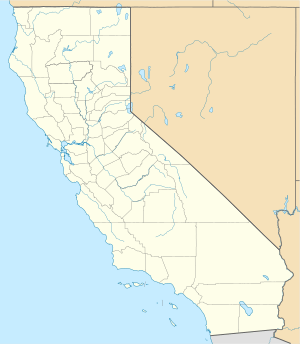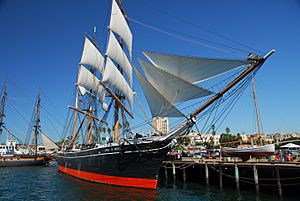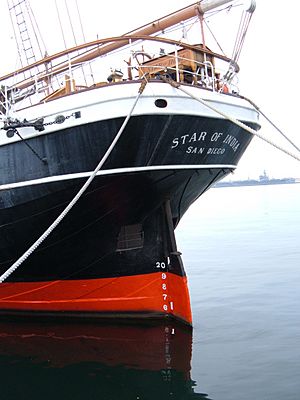Star of India (ship) facts for kids
class="infobox " style="float: right; clear: right; width: 315px; border-spacing: 2px; text-align: left; font-size: 90%;"
| colspan="2" style="text-align: center; font-size: 90%; line-height: 1.5em;" | 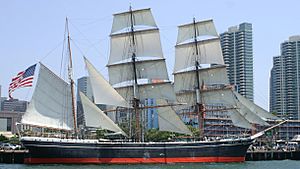
|}
The Star of India is a very old and famous sailing ship that was built in 1863. She was first named Euterpe and was made of iron in Ramsey, Isle of Man. For many years, she sailed from Great Britain to places like India and New Zealand. Later, she carried salmon from Alaska to California.
The ship stopped sailing in 1926. But in 1962–1963, she was fixed up and became a museum ship. Today, she is docked at the Maritime Museum of San Diego in San Diego, California. The Star of India is special because she is the oldest ship in the world that still sails regularly. She is also the oldest iron-hulled merchant ship that is still floating. This amazing ship is recognized as both a California Historical Landmark and a United States National Historic Landmark.
Contents
| History | |
|---|---|
| Name |
|
| Builder | Gibson, McDonald & Arnold |
| Launched | 14 November 1863 |
| In service | 1906 |
| Fate | Sold to the United States |
| Acquired | 1906 |
| Identification | IMO number: 8640337 |
| Fate | Operational museum ship |
| General characteristics | |
| Tonnage |
|
| Length |
|
| Beam | 10.7 m (35 ft) |
| Height |
|
| Draft | 6.6 m (22 ft) (fully loaded) |
| Sail plan |
|
|
Star of India
|
|
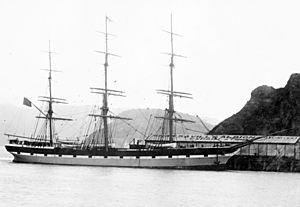
Euterpe at Port Chalmers, the port of Dunedin, in 1883
|
|
| Location | San Diego Embarcadero, San Diego, California |
| Built | 1863 |
| Architectural style | Three-masted bark |
| NRHP reference No. | 66000223 |
| Significant dates | |
| Added to NRHP | 13 November 1966 |
| Designated NHL | 13 November 1966 |
- Where the Star of India Lives
- Star of India in Movies and Shows
- Fun Facts About the Ship
- Images for kids
- See also
Ship's Journey: From Euterpe to Star of India
Early Voyages as Euterpe
The ship was originally named Euterpe after the Greek Muse of music. She was built in 1863 by Gibson, McDonald & Arnold in Ramsey, Isle of Man. Euterpe was a full-rigged ship, meaning all three of her masts had square sails. She was built for carrying jute (a type of fiber) from India for Wakefield Nash & Company in Liverpool. She was launched on November 14, 1863.
Euterpe's first voyages were quite difficult. On January 9, 1864, she sailed from Liverpool to Calcutta with Captain William John Storry. During this trip, she crashed into another ship near Wales. This damaged her front mast and other ropes. The crew refused to continue, so the ship had to return for repairs. Many crew members were even sent to jail!
In 1865, Euterpe faced another storm in the Bay of Bengal near Madras. She had to cut down her masts to survive the storm. She then went to Trincomalee and Calcutta for more repairs. Sadly, Captain Storry died on the way back to England and was buried at sea.
New Owners and Long Journeys
After her challenging start, Euterpe was sold in 1871 to David Brown of London. She made four more trips to India. Later that same year, she was sold again to Shaw, Savill and Company of London. This company later became the Shaw, Savill & Albion Line.
For the next 25 years, Euterpe carried passengers and goods to New Zealand. Each trip went eastward around the world before returning to England. Her fastest trip to New Zealand took 100 days, and her longest took 143 days. She also visited ports in Australia, California, and Chile. A baby was even born on one of her trips to New Zealand and was given the middle name Euterpe!
In 1897, after 21 trips around the world, Euterpe was sold to owners in Hawaii. In 1899, she was bought by the Pacific Colonial Ship Company in San Francisco, California. From 1898 to 1901, she made four trips between the Pacific Northwest, Australia, and Hawaii. She mainly carried lumber, coal, and sugar. She was officially registered in the United States on October 30, 1900.
Becoming the Star of India
In 1901, the Alaska Packers' Association in San Francisco bought Euterpe. They changed her sails, making her a barque. This meant her back mast now had fore-and-aft sails instead of square sails. Starting in 1902, she began carrying fishermen, cannery workers, coal, and supplies each spring from Oakland, California to Nushagak in the Bering Sea. Each autumn, she returned with her storage areas full of canned salmon.
In 1906, the company changed her name to Star of India to match their other ships. She stopped sailing in 1923 after 22 trips to Alaska. By this time, steam-powered ships were much more common.
In 1926, the Star of India was sold to the Zoological Society of San Diego, California. They wanted her to be the main attraction of a new museum and public aquarium. However, the Great Depression and World War II stopped these plans.
Restoration work on the ship finally began in 1957. Alan Villiers, a famous sailing ship captain and writer, visited San Diego. He saw the Star of India falling apart in the harbor. He told people about it, which inspired a group of citizens to form the "Star of India Auxiliary" in 1959. This group helped support the ship's restoration.
Progress was slow, but in 1976, the Star of India sailed again! Today, she is part of the Maritime Museum of San Diego. She is kept in excellent condition and sails at least once a year. Along with other ships at the museum, she hosts school tours for over 6,000 children each year. She also has a "Living History Programme" where students can experience history and teamwork during overnight visits.
The Star of India was built in 1863. She is the fourth oldest ship still floating in the United States. Only the 1797 USS Constitution, the 1841 Charles W. Morgan, and the 1854 USS Constellation are older. She is also the oldest ship in the world that still sails regularly. What makes her even more special is that her hull, cabins, and equipment are almost 100% original.
Where the Star of India Lives
The Star of India is docked at the San Diego Maritime Museum. This is just south of Lindbergh Field (San Diego International Airport). You can find her on the west side of North Harbor Drive, near Ash Street. This area is part of the Port of San Diego tidelands, a bit west of downtown San Diego, California.
The other ships that belong to the Maritime Museum are always docked north of the Star of India. Her closest neighbor since 2007 is HMS Surprise. This ship is a copy of a British frigate (a type of warship).
When the Star of India sails, she usually stays close to the coast of San Diego County. She typically returns to her dock within a day. A skilled team of volunteers from the Maritime Museum sails her. They train all year to do this. The Star of India has become one of the most famous ships in San Diego's harbor.
In August and September 2009, the Star of India was taken out of the water. She went to a drydock for a required Coast Guard inspection. She also had some maintenance done below the waterline. This work cost about $225,000 and kept her off display for 3–4 weeks. Her most recent voyage was on November 18, 2018.
Star of India in Movies and Shows
The Star of India has been featured in several TV shows and games:
- Dirty Jobs Season Four, Episode 89, "Tar Rigger"
- Ghost Hunters Season Four, Episode 426, "Spirits on the Water"
- Great Ships episode "The Windjammers"
- Haunted History Season One, Episode 3, "Haunted Ships"
- At the 2013 San Diego Comic-Con, Ubisoft used the ship to promote their new game Assassin's Creed IV: Black Flag. For three days, the ship was renamed The Jackdaw, like the ship in the game.
- Ghost Adventures Season 12, Episode 6 "Star of India"
- There Goes a Boat, episode 7 of the Real Wheels children's series.
Fun Facts About the Ship
- You can still see a faint mark from the logo of Assassin's Creed IV: Black Flag on the ship's sail. This is from the 2013 San Diego Comic-Con event.
- Star of India: The Log of an Iron Ship by Jerry MacMullen (1979, Maritime Museum Association of San Diego) ISBN: 0-8310-7027-7
- Euterpe: Diaries, Letters and Logs of the "Star of India" as a British Emigrant Ship by Craig Arnold (1988, Maritime Museum Association of San Diego) ISBN: 0-944580-06-8
Images for kids
See also
 In Spanish: Star of India (barco) para niños
In Spanish: Star of India (barco) para niños


